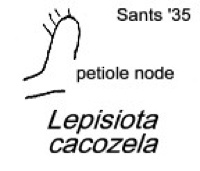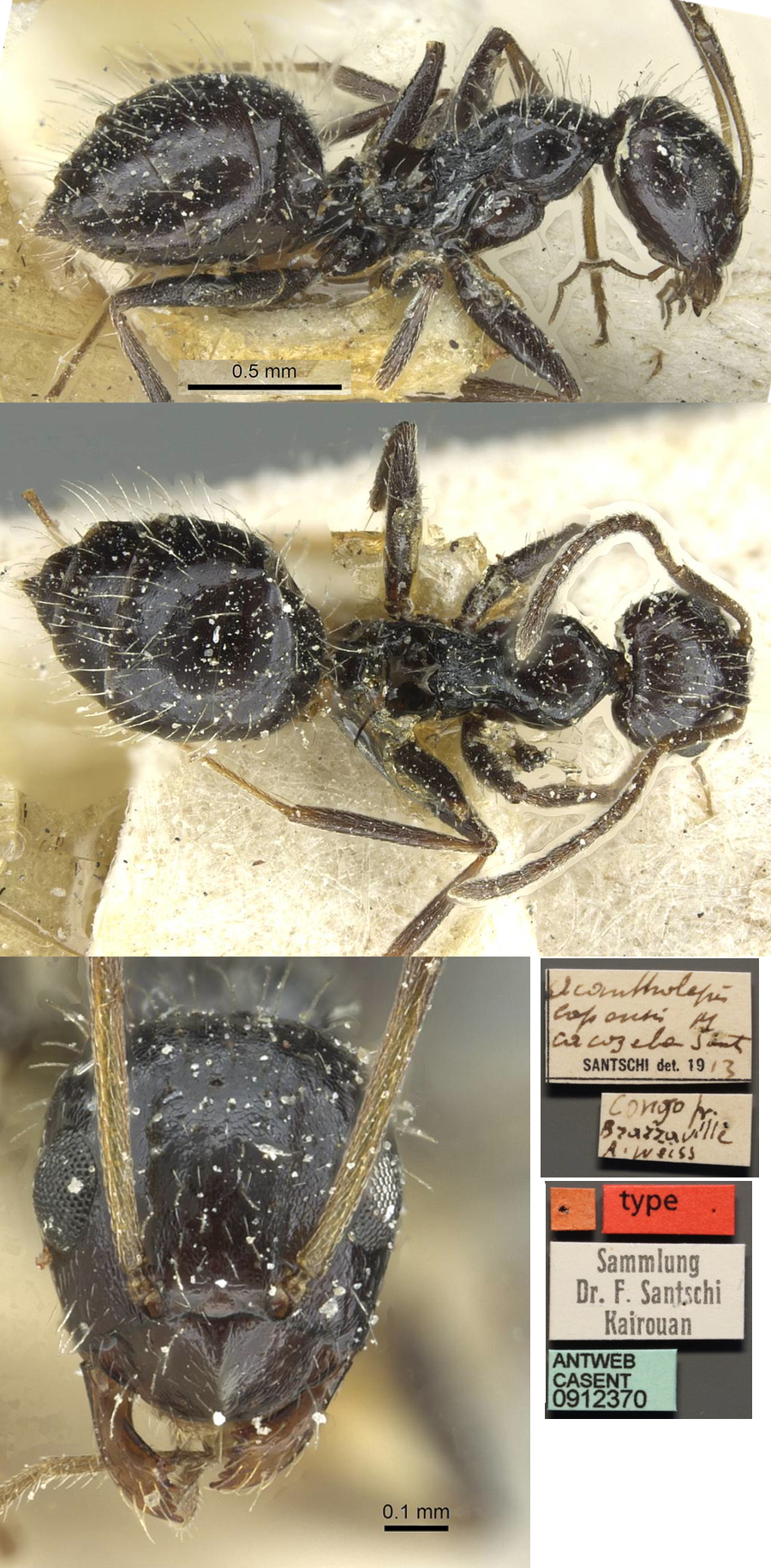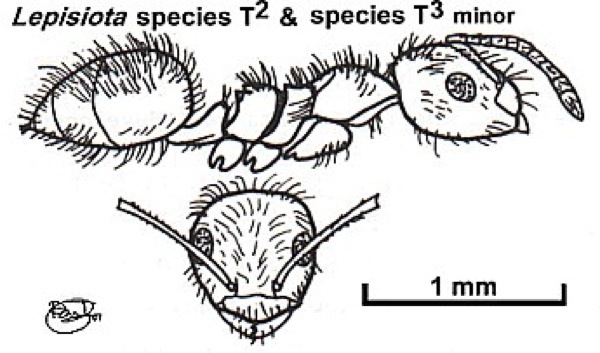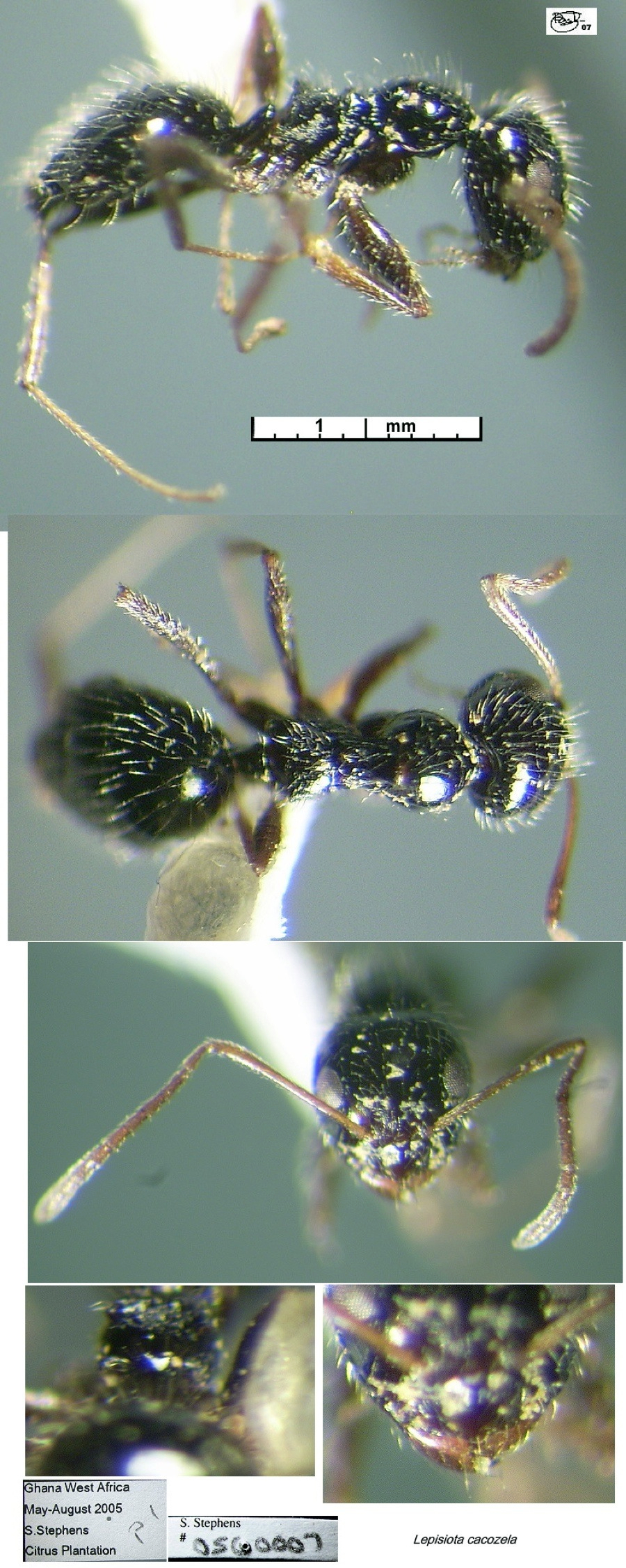Lepisiota cacozela (Santschi)
 Major Major  Minor Minor  Type location Congo (Acantholepis
capensis Mayr stirps canescens Emery var. cacozela
nov., Santschi,
1914b: 124 in key, worker, 1914d: 378; Acantholepis capensis
var. cacozela, Stitz, 1916: 395, worker; raised to species
Santschi, 1935a: 270; Bolton, 1995, gives a misleading attribution to
Stitz, 1916: 295, who merely used the name when identifying a specimen) Type location Congo (Acantholepis
capensis Mayr stirps canescens Emery var. cacozela
nov., Santschi,
1914b: 124 in key, worker, 1914d: 378; Acantholepis capensis
var. cacozela, Stitz, 1916: 395, worker; raised to species
Santschi, 1935a: 270; Bolton, 1995, gives a misleading attribution to
Stitz, 1916: 295, who merely used the name when identifying a specimen)
 . .
|
 Santschi's (1914b)
description is at Santschi's (1914b)
description is at  . As extracted from key
couplets, this is - . As extracted from key
couplets, this is -
WORKER - Petiole scale with a thick profile and only weakly emarginate;
alitrunk stocky; base colour black; erect pilosity of whitish, more or
less fine, long and abundant hairs; quite shiny; scape with non-erect
pubescence, which is shorter on the legs and genae.
Santschi (1935a: 270) had the illustration (right) of
the petiole scale and noted how it differed from Lepisiota albata
in having a face which narrows anteriorly. From my drawing, etc., the
scale shape and general appearance suggests that my Lepisiota
species T² (below) may be this species.
Wheeler (1922) listed it from Nigeria, collected
at Olokemeji by F. Silvestri; and Zaïre but had it as a variety
of Lepisiota
canescens, noting that it had longer hairs than the typical canescens
and the petiolar scale was thickened at the summit, with scarcely an
excised border. Workers were taken from the hollow stem of an
unidentified plant.
My feeling is that is a forest zone species whereas the
similar but duller looking Lepisiota canescens is a
sudano-savannah species.
|
 The
photomontage of the type worker is collated from http://www.antweb.org/specimen.do?name=casent0905866. The
photomontage of the type worker is collated from http://www.antweb.org/specimen.do?name=casent0905866.
|
Oxford University
Museum
specimens
|
 Nigeria
specimens (as Acantholepis species T² and T³, Taylor, 1978:
39). These seem to represent two species; with T² having a single morph
(as is typical for the genus) and T³ having a minor morph of similar
characters but slightly smaller and a much larger major morph. Nigeria
specimens (as Acantholepis species T² and T³, Taylor, 1978:
39). These seem to represent two species; with T² having a single morph
(as is typical for the genus) and T³ having a minor morph of similar
characters but slightly smaller and a much larger major morph.
T² morph. TL 2.61 mm, HL 0.67, HW 0.62, CI 92, SL 0.76,
SI 123, PW 0.44
T³ MINOR. TL 2.36 mm, HL 0.59, HW 0.54, CI 92, SL 0.67, SI 124, PW 0.39
T³ MAJOR. TL 3.21-3.60 mm, HL 0.90-0.99, HW 0.93-1.14, CI 103-115, SL
0.76-0.90, SI 79-82, PW 0.53-0.54
Generally black, with lighter extremities, yellow-brown on tarsi, shiny.
T² and T³ minor with abundant long, white erect hairs. Propodeal
prominences moderately acute. Petiole a thick almost emarginate scale;
suggestive of it being cacozela.
|
|
 T³
major more massive with a large head which is greater in width than
in length. Very abundant long, white erect hairs and long white
pilosity on head and alitrunk. Petiole with the dorsal margin straight
to slightly concave. T³
major more massive with a large head which is greater in width than
in length. Very abundant long, white erect hairs and long white
pilosity on head and alitrunk. Petiole with the dorsal margin straight
to slightly concave.
Apart from the curious dimorphism of T³, which seems
unusual for the genus, there is a behavioural separation with T² being
more common, especially on cocoa in Nigeria, where it can be a
sub-dominant, with Crematogaster
africana, on 5-10% of trees; and at 53/76 farms (combined
result with Lepisiota species, formerly capensis, see
above) (Taylor, 1977; Taylor & Adedoyin, 1978). Both forms,
however, will tend aphids and coccids, and build tents of vegetable and
other debris. Also found foraging on native herbaceous vegetation and
trees, and on cashew and kola.
|
Major workers |
 The photomontage is of
a major worker from
Liberia; collector E Poirier (Yekepa Camp 4 SLAM 4). The photomontage is of
a major worker from
Liberia; collector E Poirier (Yekepa Camp 4 SLAM 4).
Note: A major
worker from Ivory Coast shown at http://www.antweb.org/specimenImages.do?code=casent0906262
and labelled as "Lepisiota megacephala"
in Barry Bolton's handwriting is identical to this and the major from
Ghana (below).
|
|
 The photomontage is of
a major worker collected in
Ghana by S Sky Stephen, 2006. The photomontage is of
a major worker collected in
Ghana by S Sky Stephen, 2006.
|
Minor workers |
 The
photomontage is of a minor worker collected in Ghana by S
Sky Stephen, 2006. The
photomontage is of a minor worker collected in Ghana by S
Sky Stephen, 2006.
|
 The photomontage is
of specimens from Congo,
Dzio-Dzio, Ngabe, Région de
Pool; 3°29'33" S 15°18'33" E; 7 October 2007; collected by sweep
netting (fauchage); Yves Braet. The photomontage is
of specimens from Congo,
Dzio-Dzio, Ngabe, Région de
Pool; 3°29'33" S 15°18'33" E; 7 October 2007; collected by sweep
netting (fauchage); Yves Braet.
|
 The
photomontage is of a specimen from Benin; Collection
details - Bonou, Forêt de Gnanhouizoumè, 06°50-55 N 02°20-30'E; Pitfall
trap; S Tchibozo; 27.viii.2006. The
photomontage is of a specimen from Benin; Collection
details - Bonou, Forêt de Gnanhouizoumè, 06°50-55 N 02°20-30'E; Pitfall
trap; S Tchibozo; 27.viii.2006.
|
 The photomontage is of a
specimen from Cameroun, Awae II; 3°54’30”N 11°25’58”E; highland
area; elevation 437 m; aspirator in fallow ; 17.xii.2006;
coll. A Fotso Kuate (fk label schoutedeni). The photomontage is of a
specimen from Cameroun, Awae II; 3°54’30”N 11°25’58”E; highland
area; elevation 437 m; aspirator in fallow ; 17.xii.2006;
coll. A Fotso Kuate (fk label schoutedeni).
|
 The
photomontage of what appears to be cacozela is derived from
images at www.discoverlife.org
- originals by Gary Alpert, Harvard University; Ivory Coast specimens. The
photomontage of what appears to be cacozela is derived from
images at www.discoverlife.org
- originals by Gary Alpert, Harvard University; Ivory Coast specimens.
|
|